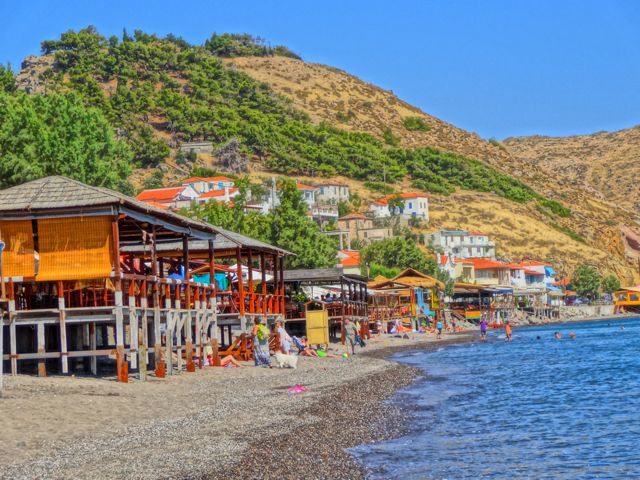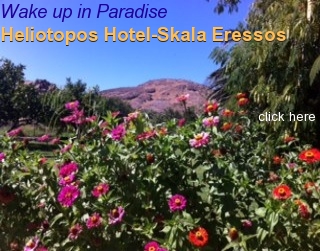
Traveling By Bicycle Around Lesvos
|
by Colleen Mcguire |
|
Also known as Mytilini, Greece’s third largest island has a network of at least 400 miles of well-maintained paved roads. With my Trek 1220 road bike, two panniers and a tent, I spent two weeks bicycling to just about every town and village in the island accessible by asphalt. With great relief and pleasure I hereby broadcast that as a single female traveler, I was never once harassed, disturbed, or pestered by any man. |
|
There are pockets of tourist activity where mostly northern Europeans cluster, yet more common are the countless empty beaches that render bikinis cumbersome. I slept on many such beaches, my tent pitched within spitting distance of the Mediterranean. A perfectly circular sun, as fiery red as a traffic light, frequently held me captive as it rose from or set into the sea. |
|
The twelve-hour overnight ferry from Athens deposited me in the capital, Mytilini, at 8:00 in the morning. Upon touching terra firma, with no pause for city sightseeing, I immediately started cycling up the island’s eastern flank. I pursued a very leisurely pace, stopping often, such as to tour several monasteries or marvel at the mountainous terrain which provided tantalizing views of the Turkish coastline, a mere two hour boat ride away. Numerous instances while cycling on a quiet mountain road, the silence was startlingly ruptured by a clamorous clink-clank-clink of metal bells dangling from a herd of at least 20-30 goats. |
|
When summer comes many of the villagers of Sikaminias move down to Skala Sikaminias, and when summer ends, they ascend back up the mountain. This unique seasonal movement occurs in other Lesvian towns, too. A resident of Eressos and Skala Eressos fascinated me with a report of how, until four years ago, for decades and decades her entire village (including merchants, doctor, pharmacy, post office, etc.) made its annual mountain-sea-mountain relocation en masse on the very same day. The beauty of Lesvos is that the islanders proudly preserve their traditions. They demonstrate a remarkable, and indeed refreshing, disinterest in developing their land into another indistinguishable McMall. They cherish a more tranquil flow to life, insisting on the two or three hour afternoon nap regardless of whether business could be transacted or profits made in that period. Siga-siga, meaning slowly in Greek, is a word readily learned. |
|
From Skala Sikaminias, I traveled about ten miles westward on a road hugging the sea more fit for a mountain bike than my 28 cm tires. But traveling ever so siga-siga, I made it safely to beautiful, photogenic Molyvos, (population about 1400), a town which under no circumstances can be missed. Its winding, narrow cobblestoned streets and elegant stone houses with loudly painted shutters set against the blinding blue sea and an imposing castle make Molyvos a destination for the romantically inclined. |
|
On that rocky coastal road to Molyvos I came across hot springs that are not “tamed” so to speak, meaning no one has enclosed them. They are just out there in the sea, no building, no sign, no fees, no people. You wouldn’t even know to look for them unless you had a “heads up” which I fortuitously received owing to my tendency to initiate conversation with every passing Greek, especially one encountered on a siga-siga type of backroad. I mentioned to the man I met that I was going to Eftalou. To my surprise he informed me that there are hot springs here too, not that far away, near the bend in the road, close to a little white boat on the beach. With those sketchy instructions, I succeeded in finding these “untamed” hot springs. I sat in bliss in hot sea water at the shore, my back resting against a smooth rock, savoring the tingling feeling of cool sea waves lapping over me. (Look for the rock with the little rocks on top of them close to the Ligaria Paradise Taverna as seen in this photo). |
|
Each village has a little plateia (square), usually with a vine-covered canopy for cherished shade. Mandatory are several coffeehouses, called cafeneons, where the men sit for hours drinking thick Greek coffee from little doll-sized white demitasse cups, “Mavro,” they’d order (black). I would bicycle into the village, often turning a narrow corner, suddenly appearing into the plateia rather dramatically from nowhere--unlike the noisy announcement of a car or motorcycle. I was invariably told that I was the only bicyclist in memory to ride into town. |
|
After a while, I would leave the center of gravity of the town, the plateia where the men dominated, and start venturing down the village’s side streets where the women prevailed. I would find them at home, sewing, cooking, relaxing on porches, or tending to animals. Young and old, seemed dazzled by my female presence on a bike. “All alone?” the women always asked in seeming admiration. A glass of water, fruit, a towel to wipe my sweat were offered to me when I visited women in their homes. I was never looked at suspiciously or with a glare of distrust. A smile always greeted my smile, coupled by direct and forthright eye contact. |
|
One thing that makes it easy to cycle in Lesvos, even through its barren western half, is the fact that you can always find water to drink. Every town has at least one fountain, and invariably you’ll come upon running water in the middle of absolutely nowhere. In the mountains, the water is usually refreshingly cold. While cycling in a pulverizing sun which Greeks have sense enough to stay out of, I’d dunk my head under the spigot and the rush it created was enough to keep me cycling until the next fountain. |
|
The flora of Lesvos enchanted me. Near Molyvos I unexpectedly set my tent next to a bush of wild rosemary and I’m certain its fragrant aroma infiltrated my dreams for the two nights I camped there. One day on an isolated road I encountered a smiling man (where had he come from?) carrying a little green and lavender sprig who handed it to me saying, “mentha,” which my dictionary translated as peppermint. I carried the wild twig in my handlebar bag for days, whiffing its energizing scent regularly. In an adorable fishing village, Niferida, an old woman cooked me louloudia. This uniquely delicious plate consists of the yellow/orange flower of the zucchini plant rolled up in a conical shape and stuffed with rice and herbs. I’d never seen or tasted anything like it. |
|
Lesvos is the Greek island where ouzo--that delightfully tasting Greek liquor that smells of anise--was born. And Plomari, a loveable town on the southeast coast, is the home of ouzo. There are actually certain brands of ouzo that can only be purchased in Plomari. Even if ouzo is not your taste, you cannot venture to Lesvos without indulging in this quintessentially Lesvian experience. |
|
Visitors to Lesvos regard this precious island as one of Greece’s best kept secrets. The people are warm and friendly. The food is divinely delicious in part because Mytilini some of Greece’s finest olive oil. There are as yet no high rise hotels or packaged jumbo jets of tacky tourists trampling all over the place. I didn’t meet a single American until I took a day-boat to Turkey at the end of my trip. For you women adventure travelers on the look-out for a female friendly, mountain-sea locale that offers physical challenges and a siga-siga charm, Lesvos is waiting to unleash your goddess spirit. |
|
|
|
|
|
Return to Lesvos Index
Join Matt Barrett's Greece Travel Guides Group on Facebook for comments, photos and other fun stuff. If you enjoy this website please share it with your friends on Facebook. If you are appreciative of all the free information you get on my websites you can send a donation through Paypal Or you can use Venmo at venmo.com/Matt-Barrett-Greece
 An ancient mystique is one ingredient which
tends to lure me to a foreign land. The Greek island of Lesvos
proved bewitchingly alluring, not least because it is home to perhaps
the oldest known female poet in history, Sappho, born in 628 BC
in the town of Eressos. A second beckoning ingredient is a
land’s potential for adventure travel, and Lesvos fit this
bill, too.
An ancient mystique is one ingredient which
tends to lure me to a foreign land. The Greek island of Lesvos
proved bewitchingly alluring, not least because it is home to perhaps
the oldest known female poet in history, Sappho, born in 628 BC
in the town of Eressos. A second beckoning ingredient is a
land’s potential for adventure travel, and Lesvos fit this
bill, too. 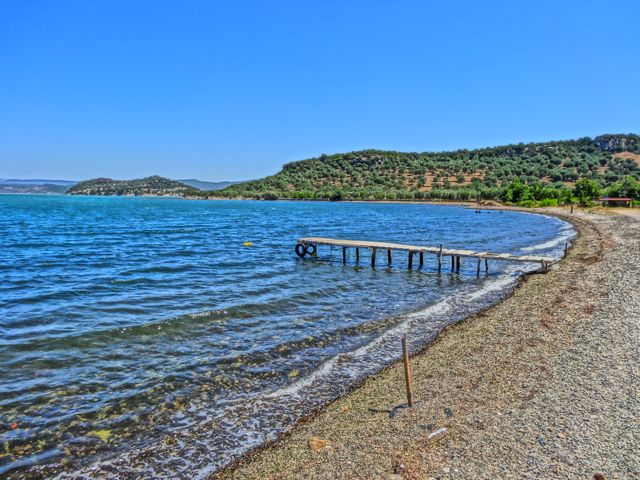 Although Mytilini with roughly 90,000 inhabitants
certainly has its share of foreign visitors, compared to Cyclades
islands such as Santorini and Mykonos, its tourism falls short of
industry proportions. As a result, you never feel crowded
and--icing on the cake--goods and services tend to be half the cost
as other Greek islands.
Although Mytilini with roughly 90,000 inhabitants
certainly has its share of foreign visitors, compared to Cyclades
islands such as Santorini and Mykonos, its tourism falls short of
industry proportions. As a result, you never feel crowded
and--icing on the cake--goods and services tend to be half the cost
as other Greek islands. 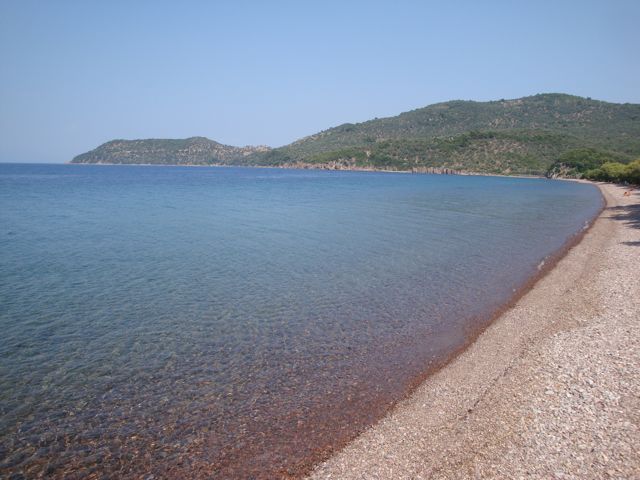 The shape of Lesvos can be likened to an upside-down
uterus with the Kaloni Gulf splitting the land into two quasi-equal
halves. The terrain of each half is so opposite the other,
it is as if you are traversing two separate islands. While
the east is flush with greenery, orchards and water, the western
half is dry and barren, having a desert feel.
The shape of Lesvos can be likened to an upside-down
uterus with the Kaloni Gulf splitting the land into two quasi-equal
halves. The terrain of each half is so opposite the other,
it is as if you are traversing two separate islands. While
the east is flush with greenery, orchards and water, the western
half is dry and barren, having a desert feel. 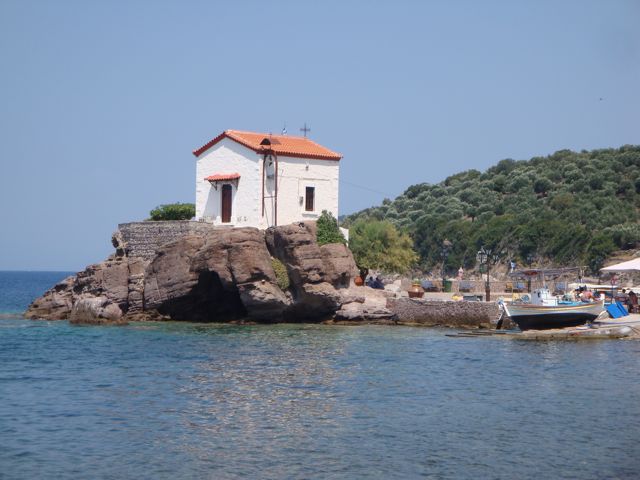 By 6 p.m. my first day, 40 miles later, I
arrived to the adorable fishing village of
By 6 p.m. my first day, 40 miles later, I
arrived to the adorable fishing village of 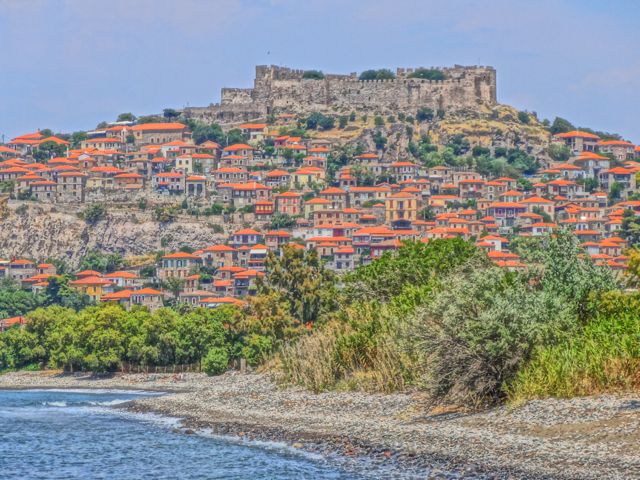 While cycling, especially in mountain terrain,
I daily passed old men riding side-saddle on donkeys. By their
warm smiles, I sensed these elders shared my sentiment that we are
allies in our embrace of a non-motorized means of transportation.
Siga-siga, they sometimes said to me in passing.
While cycling, especially in mountain terrain,
I daily passed old men riding side-saddle on donkeys. By their
warm smiles, I sensed these elders shared my sentiment that we are
allies in our embrace of a non-motorized means of transportation.
Siga-siga, they sometimes said to me in passing. 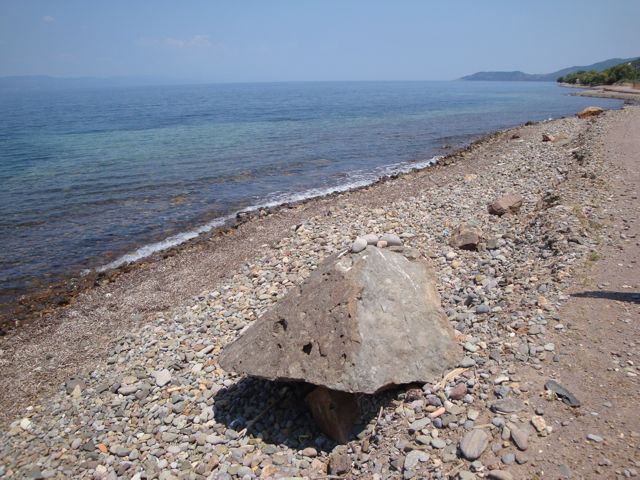 About three kilometers from Molyvos is Eftalou,
the soothing hot springs coming out of the sea. The ancient
spa is a little structure with a round white roof, a hamam as it
is called in Turkish, that is a popular tourist site famed for its
natural healing capacities. The place was closed on a Sunday
morning, but I went behind the building and sat directly in the
hot sea water, a wonderful experience, but not as heavenly as my
previous day’s discovery.
About three kilometers from Molyvos is Eftalou,
the soothing hot springs coming out of the sea. The ancient
spa is a little structure with a round white roof, a hamam as it
is called in Turkish, that is a popular tourist site famed for its
natural healing capacities. The place was closed on a Sunday
morning, but I went behind the building and sat directly in the
hot sea water, a wonderful experience, but not as heavenly as my
previous day’s discovery. 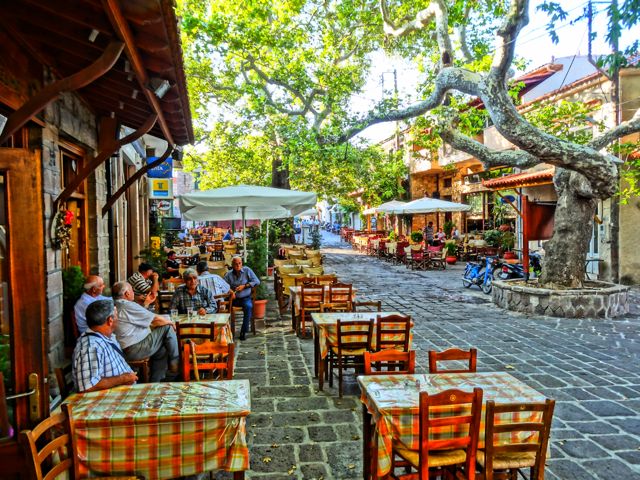 Perhaps traveling in Lesvos may not be as
rich for many as it was for me, specifically because I am able to
carry on a modest conversation in Greek. Where Athenians tend
to lapse into English with me, the mountain villagers allowed
me to speak, albeit at siga-siga pace, and tended not to interrupt
me, just patiently waiting for me to formulate my sentences. So,
I loved going up into the mountain areas to villages of 200 or 300
people, like Pterounda or Ambelika or Pelopi (whose Dukakis Street
is named for guess who?), for the experience of talking exclusively
in Greek. Besides the language barrier, these are towns by
and large ignored by European vacationers since the beach is the
premier attraction for that crowd. The villagers delighted
in welcoming a venturesome foreigner such as myself to their turf.
Perhaps traveling in Lesvos may not be as
rich for many as it was for me, specifically because I am able to
carry on a modest conversation in Greek. Where Athenians tend
to lapse into English with me, the mountain villagers allowed
me to speak, albeit at siga-siga pace, and tended not to interrupt
me, just patiently waiting for me to formulate my sentences. So,
I loved going up into the mountain areas to villages of 200 or 300
people, like Pterounda or Ambelika or Pelopi (whose Dukakis Street
is named for guess who?), for the experience of talking exclusively
in Greek. Besides the language barrier, these are towns by
and large ignored by European vacationers since the beach is the
premier attraction for that crowd. The villagers delighted
in welcoming a venturesome foreigner such as myself to their turf.
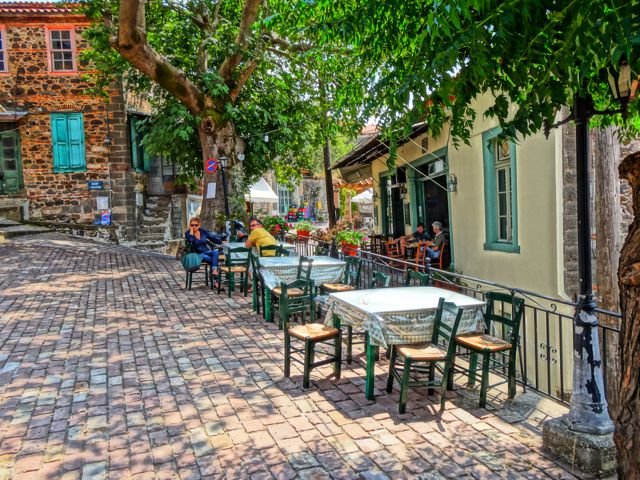 My presence always created a hubbub, probably
the talk of the week. It wouldn’t take long for someone to
engage me with the routine litany of initial questions: Where
are you from? Where is your husband? Do you have any
children? Although I don’t drink coffee, I started to
do so in Lesvos in order to access myself to the villagers. It
always heartened me to be treated by one of the elders and served
mavro in those little white cups just like the locals.
My presence always created a hubbub, probably
the talk of the week. It wouldn’t take long for someone to
engage me with the routine litany of initial questions: Where
are you from? Where is your husband? Do you have any
children? Although I don’t drink coffee, I started to
do so in Lesvos in order to access myself to the villagers. It
always heartened me to be treated by one of the elders and served
mavro in those little white cups just like the locals.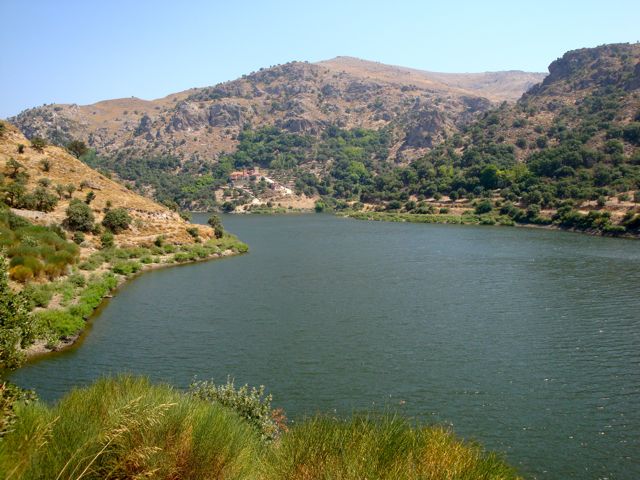 Lesvians were in constant awe of my ability
to traverse the island by bicycle. For example, going 40 or
so kilometers from
Lesvians were in constant awe of my ability
to traverse the island by bicycle. For example, going 40 or
so kilometers from  Mytilini has many novel surprises, such as,
the
Mytilini has many novel surprises, such as,
the 